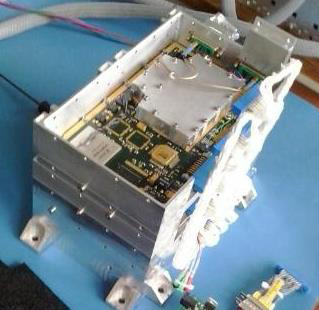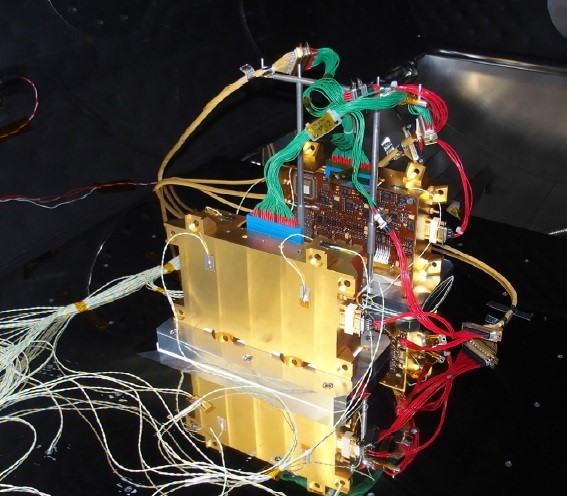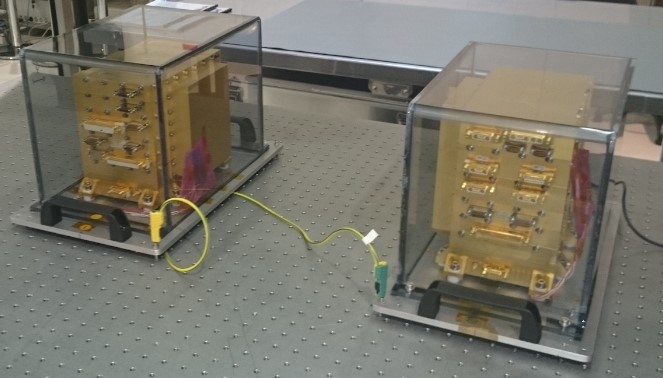
- The first combined images of TLEs and TGFs (through fast micro-cameras and photometers, nadir-viewing and X- and Gamma-ray measurements) and the associated measurements of relativistic electrons and wave fields;
- The first high resolution measurement of energetic electrons in energy, pitch angle and time allowing both to detect runaway electrons and LEPs and to track natural and man-made controlled variability of the radiation belts;
- The first on-board wave field measurements in a frequency range running from DC to 30 MHz allowing to record radio signatures of optical and particle transient phenomena and to detect the presence of quasi-electrostatic thundercloud fields.

![]() The main scientific objective of the low altitude satellite TARANIS is the study of impulsive transfers of energy between the Earth and atmosphere and the space environment. TARANIS is scheduled to be launched by the end of 2020.
The main scientific objective of the low altitude satellite TARANIS is the study of impulsive transfers of energy between the Earth and atmosphere and the space environment. TARANIS is scheduled to be launched by the end of 2020.
![]() SRC participates in the scientific program of the mission and designs the MEXIC Power Unit (MPU) - the supply block dedicated for the whole TARANIS Payload.
SRC participates in the scientific program of the mission and designs the MEXIC Power Unit (MPU) - the supply block dedicated for the whole TARANIS Payload.
![]() During 2009 the technical activities in SRC were concentrated on design and tests of the first breadboard of the supply system. A few sub-blocks have been prototyped and characterized. The draft documentation of Engineering Model of MPU has been delivered to LPCE in Orléans.
During 2009 the technical activities in SRC were concentrated on design and tests of the first breadboard of the supply system. A few sub-blocks have been prototyped and characterized. The draft documentation of Engineering Model of MPU has been delivered to LPCE in Orléans.

![]() In 2010 the first phase of prototyping of MPU block of MEXIC instrument in Taranis Mission has been finished. The block has been succesfully tested in LPCE in Orleans. MPU is based on the set of DCDC converters from STEEL equipped with the FPGA based Control and HouseKeeping system (state machine similar to that one proposed for ASIM).
In 2010 the first phase of prototyping of MPU block of MEXIC instrument in Taranis Mission has been finished. The block has been succesfully tested in LPCE in Orleans. MPU is based on the set of DCDC converters from STEEL equipped with the FPGA based Control and HouseKeeping system (state machine similar to that one proposed for ASIM).
![]() The technical activities on Engineering Model of MPU block of MEXIC instrument in Taranis Mission have been finished in 2011. The model was tested in SRC and LPC2E.
The technical activities on Engineering Model of MPU block of MEXIC instrument in Taranis Mission have been finished in 2011. The model was tested in SRC and LPC2E.
![]() Two EM models of power distribution units MPU1 and MPU2 of MEXIC/Taranis instrument (see the photo on right) were manufactured, assembled and delivered to LPCEE/Orleans in 2012. As a next step an integration with engineering models of all components of Taranis scientific payload is planned to perform in 2013.
Two EM models of power distribution units MPU1 and MPU2 of MEXIC/Taranis instrument (see the photo on right) were manufactured, assembled and delivered to LPCEE/Orleans in 2012. As a next step an integration with engineering models of all components of Taranis scientific payload is planned to perform in 2013.

![]() In 2013 the EM Models of MPE block of MEXIC/Taranis instrument have been tested and integrated with the rest of Taranis MEXIC blocks. The documentation for FM models has been finished.
In 2013 the EM Models of MPE block of MEXIC/Taranis instrument have been tested and integrated with the rest of Taranis MEXIC blocks. The documentation for FM models has been finished.
![]() In 2014 the final activities on FM Model of MPE block of MEXIC/Taranis instrument have been continued.
In 2014 the final activities on FM Model of MPE block of MEXIC/Taranis instrument have been continued.
![]() In 2015, manufacturing of the Flight Models of the MPU1 and MPU2 blocks for the MEXIC/Taranis instrument started. The modules have been partially manufactured and tested. Manufacturing and testing of the Space Research Centre PAS units is expected end in the first half of 2016.
In 2015, manufacturing of the Flight Models of the MPU1 and MPU2 blocks for the MEXIC/Taranis instrument started. The modules have been partially manufactured and tested. Manufacturing and testing of the Space Research Centre PAS units is expected end in the first half of 2016.

![]() 2016 was a very significant for TARANIS MPU blocks. This year MPU1 and MPU2 flight models (FM) has been finally manufactured and tested. In the first quarter of the year sub modules for MPU FMs has been populated by French company MATRA. After that, two month test campaign in CBK PAN facility took place. As a result, all important properties and characteristics of the system has been identified and measured for different temperatures and under a vacuum conditions. Widely tested modules were provided back to MATRA for the final assembly. Finally assembled modules has been qualified by performing a series of qualification tests. Successful thermal-vacuum cycles and vibration tests has been done in France and modules has been delivered for further activities. In 2017 it is scheduled assembly of all flight models and to perform wide range of tests with complete MEXIC system. After that TARANIS satellite bus will be assembled with payload and prepared for launch scheduled currently for end of 2018 or beginning of 2019 year. .
2016 was a very significant for TARANIS MPU blocks. This year MPU1 and MPU2 flight models (FM) has been finally manufactured and tested. In the first quarter of the year sub modules for MPU FMs has been populated by French company MATRA. After that, two month test campaign in CBK PAN facility took place. As a result, all important properties and characteristics of the system has been identified and measured for different temperatures and under a vacuum conditions. Widely tested modules were provided back to MATRA for the final assembly. Finally assembled modules has been qualified by performing a series of qualification tests. Successful thermal-vacuum cycles and vibration tests has been done in France and modules has been delivered for further activities. In 2017 it is scheduled assembly of all flight models and to perform wide range of tests with complete MEXIC system. After that TARANIS satellite bus will be assembled with payload and prepared for launch scheduled currently for end of 2018 or beginning of 2019 year. .

![]() In 2017 year the flight models (FM) of MPU modules for TARANIS satellite payload were integrated with other payload instruments and tested in flight configuration. TARANIS satellite bus is being assembled with its payload and prepared for launch.
In 2017 year the flight models (FM) of MPU modules for TARANIS satellite payload were integrated with other payload instruments and tested in flight configuration. TARANIS satellite bus is being assembled with its payload and prepared for launch.
![]() In 2019, MPU modules, integrated with the entire TARANIS satellite were intensively tested by CNES. Currently, the launch of the satellite is scheduled for June 2020.
In 2019, MPU modules, integrated with the entire TARANIS satellite were intensively tested by CNES. Currently, the launch of the satellite is scheduled for June 2020.
![]() CBK PAN participates also in the scientific program of TARANIS mission.
CBK PAN participates also in the scientific program of TARANIS mission.